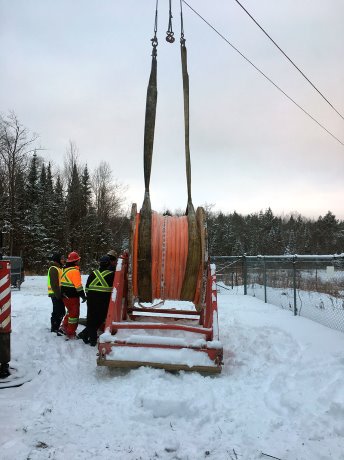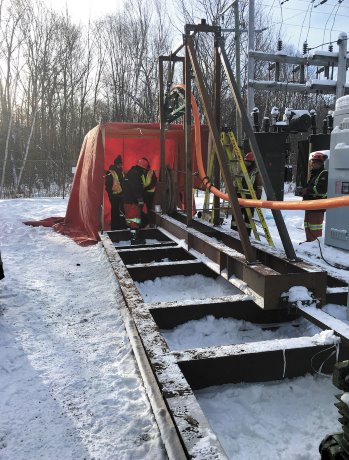Extreme weather and logistical challenges not found anywhere else in the world were just some of the hurdles encountered by electrical contractors during a project at the North American Aerospace Defense Command (NORAD) underground facility in North Bay, Ont.
"This is the first time we’ve done a big job like that," said Mike Butler, president of Amplistic Inc., an electrical contracting company, adding it had to obtain security clearance to work on the project. "It’s completely unique. It’s something you don’t experience every day. Those jobs don’t come around often."
In partnership with Paulsan Construction, the Department of National Defence (Canada) and Defence Construction Canada, Amplistic and Netquity, part owner of Amplistic, worked on the project for the North Bay Underground Complex (UGC) at the Canadian Forces Base. The purpose of the electrical project was to replace the main feeder cable for the facility.
NORAD’s UGC has a rich history. During the Cold War, Canada was situated between the war’s two main adversaries, the Soviet Union and the U.S., making the centre a prime target for a Soviet nuclear strike. In order to minimize this risk, planners decided to build the NORAD facility underground.
Construction of the UGC took four years — one-and-a-half years for excavation and two-and-a-half years to build and outfit the centre — and was completed in September 1963. The cost was $51 million, with one-third paid by Canada and two-thirds by the U.S.
Air defence operations officially began in the UGC on Oct. 1 1963 and continued for 43 years until October 2006. About 700 Canadian and American military and civilian personnel worked in the centre.
The facility is located 600 feet (60 storeys) beneath the surface of the Earth and is engineered to withstand a four-megaton nuclear blast and when completely sealed, could support 400 people for a month. To enter into the UGC there is a two-kilometre-long North Tunnel from the Air Force Base with a one-kilometre South Tunnel from further south within the city of North Bay. The complex is protected by three 19-tonne steel blast vault-type doors.
The complex consists of two sections — the Main Installation, a three-storey building inside a 430-foot-long, 230-foot-wide, 5.4-storey-high cave and the Power Cavern, which provides life support and utility services to the complex.
The cavern, the primary focus of Amplistic and Netquity’s project, is a 401-foot-long, 50-foot-wide, 2.7-storey-high chamber.
"We replaced a main feeder cable from the surface switch gear down to the switch gear in the power cavern in the underground facility," explained Butler. "What we did is we had to get rid of the old cable that was in there — 1,000 linear feet of 500 KCMIL cable we had to pull out and extract — and then we had to feed a new cable down a borehole from the surface down to the cavern…and then ran it over to the switch gear. We had to do it in a professional manner so there are no nicks in the wire."
"They had it done before and they installed it wrong and they had a big blowout because there was a big nick in the casing and the water and all the condensation started eating at it," added Butler. "It wasn’t working for a while."
Some of the biggest challenges on the project were the extreme weather conditions and working in a confined space. The facility itself is also buried under two-billion-year-old granite, which presented another unique hurdle.
"Running the wire in the Power Cavern in a small area was very, very, very challenging in itself," stated Butler. "What we had to do was put the wiring in behind these walls, so we literally were in three-foot-by-three-foot spaces crawling and trying to pull a wire.
"The cold was also a challenge. When we were putting the wire down the borehole, every time you go down 10, 20 feet, there’s a temperature change. So when the wire is that cold and it’s going down and it’s getting warmer and warmer, you get moisture down the hole and it starts to slip so we had to do a double banding on the rigging part of it to make it safe."
Amplistic has a good relationship with general contractor Paulsan Construction, said Butler, and has worked with them on other similar projects including the John Weir Foote Armoury in Hamilton, Ont. and the Col. J.A. McIntosh, DSO ED Armoury building in Cambridge, Ont.
"The project team delivered successful project execution without any safety incidents," said Butler.
The company also worked with Redpath Mining on the project, a large company out of North Bay.
"They came in and set up a whole apparatus for us to help us run the wire professionally and cleanly," said Butler. "Amplistic was there to guide the show and we did all the connections and the switch gears. We had four guys there all the time and four guys there from Redpath so it was a well-oiled machine. We had a great team."
"We are extremely pleased with the final results," said Ronald Chan, president of Netquity Corporation, in a statement. "The team completely embraced the challenges with forward-thinking and exceptional creativity."

1/3
Photo:
2/3
Photo:





Recent Comments
comments for this post are closed